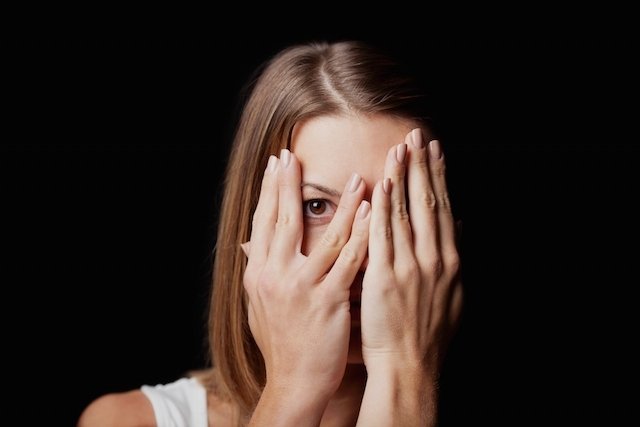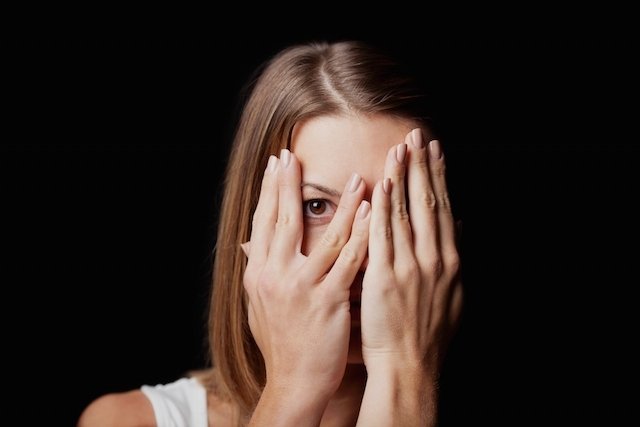Mental disorders are defined as an intellectual, emotional and/or behavioral change, which can make it difficult for a person to interact with the environment in which they grow and develop.
There are several types of mental disorders, which are classified into types, and some of the most common include those related to anxiety, depression, eating, personality or movement, for example.

The main mental disorders that tend to arise are:
1. Anxiety
Anxiety disorders are very common, present in around 1 in 4 people who go to the doctor. They are characterized by a feeling of discomfort, tension, fear or foreboding, which are very unpleasant and are usually caused by the anticipation of danger or something unknown.
The most common forms of anxiety are generalized anxiety, panic syndrome and phobias, and they are very harmful both by affecting the person’s social and emotional life and by causing uncomfortable symptoms, such as palpitations, cold sweat, tremors, lack of sleep. air, a feeling of suffocation, tingling or chills, for example, and the greater risk of developing depression or addictions to alcohol and medication.
What to do: It is recommended to undergo psychotherapy with a psychologist, in addition to follow-up with a psychiatrist who, in some cases, may recommend the use of medications that alleviate symptoms, such as antidepressants or anxiolytics. It is also recommended to carry out physical activity and, in addition, it may be useful to invest in natural methods or leisure activities such as meditation, dance or yoga, as long as they are guided by a doctor. Learn more about the different ways to treat anxiety.
2. Depression
Depression is defined as a depressed mood that persists for more than 2 weeks, with sadness and loss of interest or pleasure in activities, and may be accompanied by signs and symptoms such as irritability, insomnia or excessive sleep, apathy, weight loss or weight gain, lack of energy or difficulty concentrating, for example. Understand how to know if it is sadness or depression.
What to do: to treat depression, consultation with a psychiatrist is recommended, who will recommend treatment according to the severity of the condition and the symptoms presented. The main way to treat depression is the combination of psychotherapy with a psychologist and the use of antidepressant medications prescribed by a psychiatrist, which include Sertraline, Amitriptyline or Venlafaxine, for example.
3. Schizophrenia
Schizophrenia is the main psychotic disorder, characterized as a syndrome that causes disorders of language, thought, perception, social activity, affection and will.
This disorder is more common in young people, in late adolescence, but can appear at other ages, and some of the most common signs and symptoms are hallucinations, changes in behavior, delusions, disorganized thinking, changes in movement or superficial affect, for example. Learn about the main types of schizophrenia and how to identify the symptoms.
What to do: psychiatric monitoring is necessary, which will indicate the use of antipsychotic medications, such as Risperidone, Quetiapine, Clozapine and Olanzapine, for example. Furthermore, family guidance and follow-up with other health professionals, such as psychology, occupational therapy and nutrition, for example, are essential for the treatment to be completely effective.
4. Eating disorders
Anorexia nervosa is one of the most common eating disorders and is characterized by intentional weight loss, caused by refusal to eat, distortion of one’s own image and fear of gaining weight.
Bulimia, which is also relatively common, consists of eating large amounts of food and then trying to eliminate the calories in harmful ways, such as inducing vomiting, using laxatives, very intense physical exercise or prolonged fasting.
Eating disorders are more common in young people, and have become increasingly common due to the culture of aesthetic appreciation. Although anorexia and bulimia are the best-known eating disorders, there are other problems related to eating such as orthorexia, in which there is excessive concern about eating healthy foods. Find out what the main eating disorders are.
What to do: there is no simple treatment to cure eating disorders, psychiatric, psychological and nutritional treatment is necessary, and medications are usually only indicated in cases of associated illnesses, such as anxiety or depression. Support groups and counseling can be good ways to complement treatment and obtain good results.

5. Post traumatic stress
Post-traumatic stress is the anxiety that arises after being exposed to a traumatic situation, such as a robbery, a death threat or the loss of a loved one, for example. Generally, the affected person persistently relives the event with memories or dreams, and experiences intense anxiety and psychological suffering. Check out how to know if it’s post-traumatic stress disorder.
What to do: treatment is carried out with psychotherapy, where the psychologist seeks to help understand what events are causing involuntary fears and how they can release the traumatic memories of these events. However, in some cases, it may also be necessary to consult a psychiatrist to recommend the use of medication, such as antidepressants or anxiolytics, to alleviate symptoms.
5. Somatization
Somatization is a disorder in which the person presents multiple physical complaints, referring to different organs of the body, but which are not explained by any clinical change. Generally, these are people who constantly go to the doctor with many complaints, and during the medical evaluation, physical examination and tests, nothing is detected.
In most cases, people with somatization disorder experience anxiety and mood changes, in addition to being impulsive. When, in addition to feeling, the person actually simulates or intentionally causes symptoms, the disease is called factitious disorder.
What to do: psychiatric and psychological support is necessary, so that the person can alleviate the symptoms. Medicines such as antidepressants or anxiolytics may be necessary in some cases. Learn more about somatization and psychosomatic illnesses.
6. Bipolar disorder
Bipolar disorder is a psychiatric illness that causes unpredictable fluctuations in mood, ranging from depression, which consists of sadness and discouragement, and mania, impulsiveness and excessively extroverted characteristics. Understand how to identify and treat bipolar disorder.
What to do: treatment is usually carried out with mood stabilizing medications, such as lithium carbonate, which must be recommended by a psychiatrist.
7. Obsessive-compulsive disorder
Also known as OCD, this disorder causes obsessive and compulsive thoughts that harm the person’s daily activity, such as excessive cleaning, obsession with washing hands, need for symmetry or impulsivity for accumulating objects, for example.
What to do: treatment for obsessive-compulsive disorder is guided by a psychiatrist, with the intake of antidepressant medications, such as Clomipramine, Paroxetine, Fluoxetine or Sertraline, and cognitive-behavioral therapy is also recommended. Learn more details about how to identify and treat this disease.
Other mental disorders
In addition to the disorders indicated above, there are also others that are described by the Diagnostic and Statistical Manual of Mental Disorders (DSM-5), such as:
- Psychotic disorderssuch as schizophrenia or delusional disorder;
- Personality disorderssuch as paranoid, antisocial, borderline, histrionic or narcissistic types, for example;
- Substance use disorderssuch as illicit drugs, alcohol, medicines or cigarettes, for example;
- Neurocognitive disorderssuch as delirium, Alzheimer’s or other dementias;
- Neurodevelopmental disordersuch as intellectual disabilities, communication disorders, autism, attention deficit hyperactivity disorder or movement disorders;
- Sexual dysfunctionssuch as premature or delayed ejaculation;
- Sleep-wake disordersuch as insomnia, hypersomnolence or narcolepsy;
- Paraphilic disordersrelated to sexual desire.
If you suspect a mental disorder, it is very important to consult a psychologist or psychiatrist, so that the necessary assessment can be carried out, the diagnosis identified and the most appropriate treatment initiated.





